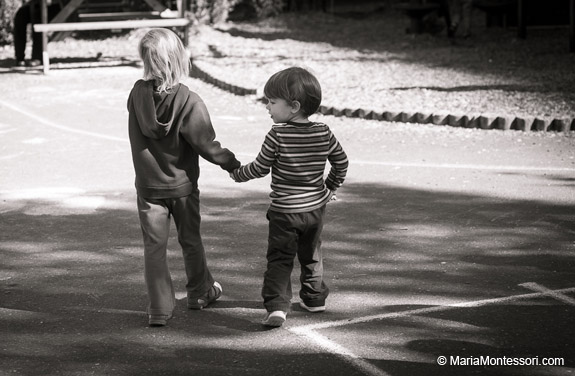
November 2, 2022
They came in from the playground knotted together by tight feelings for their injured friend. “He’s hurt. He fell off the slide. Ned pushed him.” Ned was supporting Bart, who was hopping along, his face squeezing out tears and his jaw clenching in sobs. Breathing heavily, pushing and stumbling, with heads bobbing and backs bent as they jockeyed for close, clear gaps at the bloody knee, Ned and Bart’s buddies accompanied them to gain the safety and reassurance that presenting the disaster to me always bestows.
“Looks as if it hurts. It’s bleeding.” I put one arm around Bart’s shoulder and a hand behind his calf. “Let’s clean it up.” I think fondly of Ned and how far he has come to be helping in from the playground the child he has injured rather than fleeing to the farthest reaches after attacking out of perverse curiosity. I look at nine-year-old Ned’s face which now glows with compassionate and tender empathy. He murmurs inquiries and proffers consolation, his own face bloody-knee level, and his eyes softly fixed on Bart’s face.
“Bad accident?” I ask Ned. “Not exactly,” he answers. “Didn’t mean to push that hard?” I pursue. “Mmmm, can’t say that,” Ned says. “Didn’t think it would do this much harm?” I continued. “That’s not it. Just feel bad now. I don’t do these things much anymore. Just sorry.”
This description of an ordinary incident in the daily lives of our children demonstrates the healing effect of our faith in the innate goodness of a child, our trust in his impulse to overcome negative behavior, and to heal from within through the benefits of an environment which meets his needs. This quality of recovery and healing cannot be brought about through punishment, especially not through physical punishment, which engenders deeply buried anger at best and carefully disguised revenge at worst. The superficially improved behavior achieved through punishment only masks the child’s real feelings and makes them unavailable for remediation.
Cooperative problem-solving between adult and child engages the child’s innate energies and vital instincts of self-preservation and forms a powerful partnership in the benefit of the child. Punishment sets up an adversarial relationship between adult and child within which the child’s urgent and relentless drives of self-interest are placed in conflict with the adult’s legitimate and essential guidance of the child.
In the case of Ned, described above, we see the results of a three-year process of working through the violence of a child driven by an unbridled perverse curiosity and an absence of impulse control. Ned was hooked on the self-indulgence of hurting others for the mere experience of hurting others. He enjoyed the strange mix of feelings evoked by his urge to hurt someone, his pity for the person, his temptation to indulge, his resistance of the temptation, his eventual yielding, the pleasure of inflicting pain, the guilt, the overall pleasure in the sequence and mixture of the whole affair. It appealed to his lively intelligence, perverse curiosity, and intense sensitivity. It also masked the relentlessness of his pain. To break this cycle, Ned’s full partnership and participation were required.
Punishment would have pitted Ned and me against one another. We would have wasted valuable time and energy matching wits and competing, countering and reacting, and generally trying to outmaneuver each other. He would have developed layers of disguises with his sophisticated and wily intelligence. We would have gradually but certainly diverged in our goals until Ned either became “incorrigible” or until he was “reformed.” We know what incorrigible means. What does reformed mean when it is a result of punishment? It means “I surrender.” It means “you win.” But the child never really surrenders. He just goes underground. He presents himself as compliant and socially adjusted. But when he is very, very tired or under intense pressure, or any time he calculates that he will not get caught, the buried emotion rises and the repressed behavior re-emerges.
Ned’s potency would have been dangerous in disguise or underground but in partnership with me, it was a creative force for healthy growth. My task was to enter into Ned’s reality, decipher his code, scan for his guiding star and follow it with him. Then I could see what path he had chosen and how he might be strengthened to find a better path without forsaking his star.
For Ned, the star was his exceptional intelligence wedded to a throbbing sensitivity. The mean path he had chosen, which easily could have turned cruel, was one he stumbled upon to deaden the pain of a tortured family life and an intelligence blocked from its legitimate expression through academic pursuits. Focusing the loose cannon of his randomly aimed and rapidly firing attention and breaking the code of written language were the challenges Ned faced in removing the roadblocks from his true path. While assisting Ned to spare his classmates and supporting his classmates to remain open to Ned, I began a high-intensity partnership with him to seek out and proclaim his every second of increase in focused attention, his every cramped and twisted pencil stroke, each sight-read or sounded-out syllable and each and every incident of kindness on his part.
Slowly the group of children began to coalesce and disperse in changing ebbs and flows of support and friendship for Ned. It asked a lot of them. The children were tested and found wanting at times. But many other times they came shining through. When one child would grow tired of sitting beside Ned, we would ask, “Who will trade places with Nora? She needs a rest from sitting next to Ned.” “I really like Ned, she would avow, and I want to sit next to him again someday, but it is hard work and right now I need a break.”